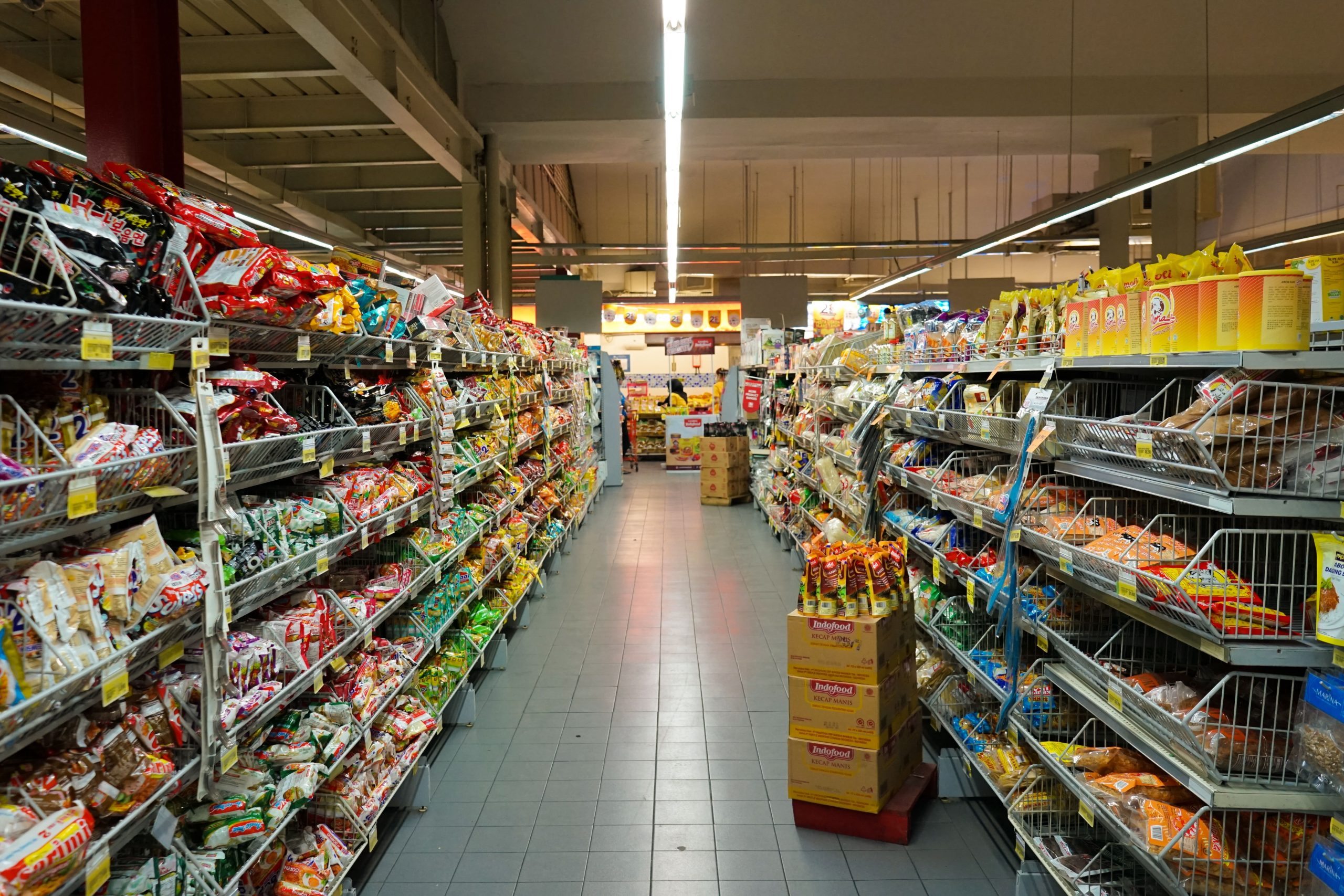In a recent video by NYT Cooking, “Why Do Grocery Stores Still Have Ethnic Aisles?,” the confusion behind the specialized shelf has resurfaced for debate. While perusing her local grocery store, the NYT reporter Priya Krishna asks if the “ethnic food aisle” is necessary. Even as the nation continually reaps the benefits of a blended society, where is the line drawn when it comes to something as timeless as the American grocery store?
Weaving her way through the ethnic aisle, Krishna is surprised by the hidden gems that she finds: From spices and beans to more varieties of sauces than she has time to list, the ethnic food aisle hosts an abundance of cultural goods. However, the reporter is also wary of the ethnic aisle as “the global smorgasbord that has long been a fixture of American groceries — wide-ranging, yet somehow detached from the rest of the store.”
Krishna explained that “all of these countries from around the world are sort of smushed into this one place,” which begs the question: What cultures fall into the American-defined category of “ethnic” food? It’s not uncommon to hear about foods being “smushed,” “crowded” or “contained” in the ethnic aisle; the constraints of the physical aisle itself impose limitations on the variety and diversity of the products being offered. The reporter’s quest closes with a “plurality of opinions” regarding the ethnic aisle but she cannot draw a solid conclusion as to how purposeful it is. The communities that are for and against these aisles both have genuine concern for the availability of its items to the world at large, revealing — if anything — a deep mindset of care for the community.
The ethnic aisle, by the nature of its name, exists as something “other” than the normalized “whole” of the store. It minimizes the constituent parts of non-Western and non-American cuisines to singular and physically narrowed sources — so what does that have to say about the value and presence of multiple cultures in the everyday supermarket?
Multicultural cuisines are a beloved and valued part of modern American dining, which is something to admire about the success of culturally pluralistic spaces. Acknowledgment of these subtle, everyday actions that involve interacting with ethnicities other than our own reflect on the mixed communities that we live in.
When our plates can echo these societies that we subscribe to, it’s too easy to assume that every other part of our social spaces will follow suit. Unfortunately, there are still structures in our mixed communities that have yet to catch up with the diverse experience of people as individuals. For example, the unchanging and reliable grocery store can be the grounds for studying this cultural phenomenon of conflict — behold, the ethnic aisle.
To those who don’t frequent this mysterious place as often as others, the “ethnic aisle” is an aisle of a grocery store that typically contains products that would be considered non-Western items and non-American/Americanized foods. The grocery store seems as if it would not be a place for tension, but the fanaticism seen through the obsession with chain groceries makes the ethnic aisle a more relevant debate than ever.
While the intention of the ethnic aisle is to do good by both the consumer and the supplier, there is still an element of division and subtle hierarchy that wafts through the pantry goods. From immediately stepping into any grocery store, the labels that hang above each aisle act as restrictive and cold barriers between what certain types of food are. These labels become so utterly tied to the products themselves that you would not imagine finding them anywhere else. Identity found in the ethnic aisle becomes the center of its problems in the same way: Because the ethnic aisle is boiled down to the singular term “ethnic,” there is a domino effect of suppressed representation that is carried throughout the aisle. More specifically, the “suppression” aspect of representation manifests itself as “ethnic” foods that only thrive in the confines of the ethnic aisle.
To pigeonhole “other” ethnicities by their presence on the marketplace shelf puts pressure on the products to fully represent cultures. The reality is that you cannot know everything about a culture from a can of vegetables or a bottle of sauce. Despite the obvious, the small selection of what is considered “ethnic food” in the American grocery store potentially damages and disrupts the majority’s view on food cultures.
One common example is curry. If there is only one type of Indian or Japanese curry on the shelf, then that “snapshot” product will represent those cultures to people unfamiliar to them. While this can hold good intentions, it also prompts the watering down of culture for a Western palate. Again, even if the consumer can recognize that the ethnic aisle can only supply so many different varieties of products, the lack of food diversity can still be disappointing from the perspective of representation.
Additionally, many of the foods in the ethnic aisles are already incorporated into everyday American culture: The norm of ordering Italian-style pizzas, Chinese takeout, Indian curries, Japanese sushi, etc., is a part of existing in these mixed-identity communities. If people are already familiar with these foods embedded into their lifestyles, why must the grocery store let the ethnic aisle stand tall? Instead, breaking down the barriers of the ethnic aisle should usher in a future that watches “the ‘ethnic’ label dissolving as foods are absorbed into the American food lexicon.”
The NYT video coincidently provided a platform for debate in its comments section from avid grocery enthusiasts. One viewer added, “I only wish that the foods stocking the ethnic food aisle were more authentic.” The diversity of the ethnic aisle comes to a standstill when the existing options are molded to fit a Western taste, comfort and recognition. Oftentimes, they don’t even have truly “authentic” versions of the items in question. For reference, you can compare a Japanese brand of soy sauce with its Walmart counterpart. Though both can serve the same purpose — and most likely taste the same — it is a fact that many people must use the Americanized or Westernized versions of products to get their ethnic food fix. Is it because there is a lack of demand for such a product, or is it because an authentic version would be too unfamiliar to the masses?
In a conversation recalled in Epicurious, the writer recounted a historian’s perspective on the issue of the ethnic aisle: “Because what’s in the ethnic food aisle is about the brands, not the food. It’s about how that food is being framed.” The ethnic aisle remains the home base for a slew of cuisines and cultures that could very well occupy your own dinner table, and yet the representation within the aisle itself is less than ideal.
With American brands making their way into the ethnic aisle, the marginalized ingredients are pushed into the darkness of difference by an “updated” form. This backhanded ostracization and subtle privilege of some cuisines over others establish a power struggle that is not visible to the customer’s eye. If there is a smaller variety of items holed up in the ethnic aisle, then shoppers will resort to making rounds in the American and Western food aisles to collect their weekly groceries.
Despite the ethnic aisle being synonymous with the “sad aisle in the back of the store,” there are benefits to having that resource accessible in your friendly neighborhood grocery store. Ethnic aisles, while possessing problematic undertones, also serve as cultural entry points to communities that might not have the privilege of such exposure. In less metropolitan areas, the ethnic aisle can be the recognizable crutch to fall back on for familiar tastes. To point out the obvious, not everyone lives in a hustle-and-bustle city of diverse eateries like Los Angeles or New York City, so getting by with the ethnic aisle is the closest one can get. Though there has been a rise in appreciation for ethnic grocery stores in the last few years — which offers a wider playing field than the typical ethnic aisle — these shopping havens are still only accessible in certain areas. The ethnic aisle is left as the obvious, positive solution to get people their desired delicacies in a timely manner.
Some might find comfort in the ethnic aisle from the familiarity of knowing where to go to find the ingredients that fit your needs, because “labeled aisles make items easy to find, and for the uninformed, easier to identify and try the unfamiliar.” For those who love the ingredients of the ethnic aisles, the categorization allows for simplified searching to calm the shopping frenzy. As the following NYT Cooking comment wrote, “When you go to the ethnic aisle you’re sure to find the specific product you’re looking for and you don’t have to search all over the freaking store.”
But for those who are new to the cuisine, the ethnic aisle provides stepping stones into new flavors. One commenter in Krishna’s report — who clearly identifies with American culinary culture — recalled her affections for the ethnic aisle: “I find that almost everyone else’s cuisine is much more interesting and flavorful and fun to cook than American cuisine.” As far as comfort is concerned, the ethnic aisle serves a distinct purpose, but that doesn’t excuse the fact that it is bound with the privileging of cultures implied by grocery aisle hierarchies.
In the same breath that can bicker over the presence of the ethnic aisle, one can debate how a consumer’s privilege plays into the entire system of supermarkets. For example, there’s an underlying question of how access to diverse cuisines uplifts or hinders their presence in society. Historically speaking, grocery store chains have catered to the tastes of a postwar America for decades, displaying the “exotic” or “foreign” foods that people are curious to eat. This immersion in culture through cuisines is favorable toward building a multicultural world. For the most part, testing and trying things outside of one’s comfort zone is encouraged across all cultural bounds.
What makes the situation new in a refreshed 2021 world is how everyone is more cognizant about the language and the meanings that we use in our everyday routines. Even things that seemingly need no other thought — such as the categorization of foods in a grocery store — can speak volumes to the care and privilege that we tie to language.
In this respect, is the point of contention in the ethnic aisle the title of being “ethnic” and what foods should be labeled as such? While the ethnic aisle sports a hefty variety of foods, the reality of the “ethnic” label “has nothing necessarily to do with the quality of ingredients or the style or complexity of a given dish — it’s simply about where it’s from.” While the unfamiliar can be daunting in a positive way, the tendency for mainstream American cuisine to fall back on a Western default cuts itself off from other cultural delights.
As one personal blog puts it bluntly, “‘ethnic food’ can also be foods that Americans don’t generally understand.” Removed from the obvious bias that this author has, the statement sheds light on the autonomous nature of American culture and the reluctance to try new things. People justifying that they “like what they like,” and never venturing down uncharted taste territories, forms both a predictable and ironic mindset. For one, the individualistic nature of Western societies allows everyone the freedom that comes with choice and expression, especially when it comes to people choosing to stick to what they’re comfortable with.
However, with modern American society celebrating differences instead of shunning them each day, this apprehension to trying new things seems trivial when the social world is in constant flux. If anything, trying new foods is a risk-free way to immerse oneself in a culture not their own. The landscape of eateries in today’s world is saturated with various cuisines, which makes the road to a multicultural mindset more accessible than ever before.
NYT reporter Krishna concluded, “There is no definitive answer to the question, ‘is the ethnic aisle a good thing or a bad thing,’ and what is the alternative to the ethnic aisle.” The meaning behind the ethnic aisle can be tricky to navigate around, with conflicting opinions coming in from all angles. At the same time, the layers behind what grocery stores are capable of offering and the consumer’s demand all spark a debate around who gets to steer the shop to their advantage. Through it all, the journey from shelf to plate is just as chaotic and colorful as our own communities, so would we want it any other way?

















